As one of the most widely spoken languages in the world, there is no shortage of options for those who want to learn Spanish.
When it comes to the most popular of the romantic languages, the problem is actually that there are so many resources and Spanish learning methods out there – it’s overwhelming.
This article for learning Spanish starts at the very beginning, where we assume that you’re a Spanish beginner – zero knowledge. We’ll guide you through each step of your Spanish learning journey, and in the latter part, we will answer common FAQs that Spanish students often have. This should cover everything you need to get started and progress, allowing you to channel your newfound enthusiasm into actual learning rather than being stuck and caught up in planning your learning process.
If you want to cut to the chase and just see reviews, recommendations, and various language-learning resources, check these posts:
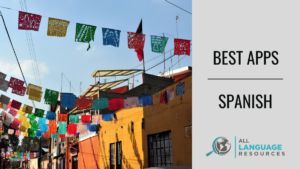





First, we’ll take a look at some of the internal processes involved in learning a new language: goal setting, mindset, and study habits. Then, we’ll explore some popular theories related to language acquisition and how you can use them to improve your Spanish right away. Finally, after identifying specific challenges and solutions at every level of Spanish, we’ll detail some handy self-study techniques and tools that you can use to reach your Spanish learning goals.
Spanish language learners are often confronted with a host of difficult questions: Are some people just naturally good at languages, and others aren’t? How long does it take? Can adults even learn languages? Do you need to move to Spain to learn Spanish? What exactly did the people who have learned Spanish actually do?
Language learning is a personal experience at its core, and what works for some simply might not work for others. In this post, we aim to shed light on the Spanish learning process: practical tips, solid strategies, quality resources, and effective advice.
Learning Spanish is a long process that’s anything but straightforward. But with the right tools and a realistic perspective, it’s absolutely within reach. Learn Spanish with these tips, strategies, and advice from a Spanish learner. How to learn Spanish? Is Spanish hard to learn? Find out here. Read on to learn more about how you can reach your Spanish learning goals.
Table of Contents
How to Learn Spanish: Start Mapping Your Path

One of the most important aspects of a language-learning journey is an understanding of where you’re headed. You could spend the rest of your life learning Spanish, trying to achieve as close to native-speaker fluency as possible, or you could spend a few weeks learning phrases to help you get around in a Spanish-speaking country and call it good.
Setting concrete goals is an excellent way to keep expectations in check, make rewarding progress, and take the most efficient study route. Consider the tried-and-true SMART method of goal setting to get the best start — these are goals that are Specific, Measurable, Achievable, Relevant, and Time-based.
Revisiting your goals as you accomplish them and checking progress is a fantastic way to stay motivated and maintain a realistic perspective.
The Power of Mindset
Before you learn even one word in Spanish, there’s something powerful you can do for yourself to improve your chances of success: be intentional about your mindset.
Learning a language is such an effort- and time-intensive endeavor that mindset will play a huge role in your experience. It influences your level of motivation, sense of progress, and reactions to making mistakes, among other things.
A Healthy Perspective
Learning a language is such an expansive experience that it’s sometimes difficult to maintain a broad enough perspective. While you’re reproaching yourself for a mistake made in conversation or rubbing your temples in frustration over a mind-boggling new concept, it can be easy to forget how far you’ve come and that these experiences are necessary steps in the journey.
Keeping things in perspective may require constant effort, but it’s a battle worth fighting. Here are some things to remind yourself of when feeling weary:
Mistakes are necessary
If you never make any mistakes while learning Spanish, you probably aren’t learning very quickly. In fact, Benny from Fluent in Three Months claims that it’s the only way to learn a language.

The sooner you accept the fact that mistakes are necessary and that everyone makes them, the better you’ll be able to handle them when they happen. For inspiration on how to actually handle mistakes when they occur, see this video by Luca Lampariello.
Progress isn’t always obvious
It’s important to feel like you’re making progress with Spanish — otherwise, why continue? However, it isn’t always easy to see how far you’ve come or how quickly you’re improving. Taking time to acknowledge that you are indeed improving is important, and it can be helpful to seek out specific examples.
There are a couple of ways to do this. Taking placement tests is one way to measure your progress, and there are plenty of free options. If one of the resources you’re using offers these tests, it can be a good idea to take them periodically. Otherwise, you might try this one by Lengalia, this one by Cervantes Escuela Internacional, or this one by Kwiziq.
Another way to measure progress is to set small, incremental goals. Evaluating your progress by regularly checking whether you’re meeting your goals is a great way to stay on track and see the bigger picture.
Growth mindset vs. fixed mindset
Psychologist Carol Dweck details how the difference between a growth mindset and a fixed mindset can have an enormous impact on children in this inspiring talk at Stanford University, but it’s relevant to adults as well.
In basic terms, someone with a growth mindset believes that they can get better at things and views challenges as opportunities to improve. Someone with a fixed mindset, on the other hand, might believe that their core intelligence can’t be improved, leading to a sense of defeat or resignation when faced with challenges.
Clearly, one of these is more conducive to making sustained, long-term progress with a language. Fortunately, a growth mindset is something you can develop intentionally; check out this article with tips for cultivating a healthy mindset.
Don’t wait for a sense of arrival
When will you be done learning Spanish? While the answer to this question depends on your goals, the truth is that you might never be done. In other words, there will always be something you can learn more about or improve.
Simply understanding that there will always be things you don’t know and can improve on is powerful. It can save you from disappointing disillusionment down the road.
Forming Good Study Habits
If there was a secret to actually learning a language, there’s a good chance it would have to do with study habits. You simply can’t learn a language without regular, focused practice. This may sound obvious, but making language study a regular part of your life is easier said than done.
Deliberate practice: This term originally refers to research done by Anders Ericsson, a psychologist whose work has influenced the modern understanding of expertise.
In relation to language learning, the term essentially refers to the act of seeking quality practice over quantity of practice — basically, finding ways to maximize focus while studying should yield better results than trying to study as much as possible. This article does a great job of explaining the concept further.
Pomodoro technique: Developed by Italian Francesco Cirillo, this time management method is used to reduce distractions while working on a task and to encourage flow states. It got its name from the tomato-shaped timer that Cirillo used (pomodoro is “tomato” in Italian).
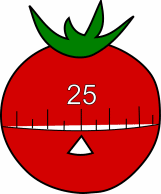
The technique is quite simple: work for 25 minutes, take a short break of 3-5 minutes, and repeat. After completing four sets of 25-minute work periods, take a longer break of 15-30 minutes.
Ideally, these short, focused work periods will make your study time more efficient. This study by the University of Illinois shows how short breaks from a task can help maintain long-term focus.
There are many free Pomodoro timers available on the internet. This one allows you to customize the length of your work periods and breaks. Of course, this technique may work better for some than others.
Staying organized: One popular method for staying on top of your progress is to keep a language-learning journal. Paper journals have the advantage of being fully customizable, and some learners enjoy the tactile experience they provide.
In addition to writing down key information and phrases you want to remember, you can keep track of your goals and easily see how far you’ve come.
There are plenty of different ways to go about keeping a journal; for inspiration, check out this example from Winza101 or this set up by Sunshine and Stationary. For more ideas on goal-tracking in particular, see Rob Macpherson’s advice on keeping language tracking sheets.
For the more technically minded, consider using Notion. It’s an all-in-one workspace that really does just about anything: create lists, kanban boards, tables, and pages; embed videos; manage timelines and set due dates — if you can imagine it, you can probably do it.
Rob MacPherson has an excellent video for language learners interested in using the application.
Language Acquisition Concepts for Your Spanish Learning Journey
There is an incredible number of ways to learn a language, and there are just as many opinions on which is best. There are plenty of linguists — Chomsky, Krashen, Selinker, to name a few — that have dedicated their lives to the study of language acquisition and use.
Fortunately, learning Spanish doesn’t require a degree in linguistics. That said, there are some key ideas and associated techniques that could be well worth implementing. We’ll take a look at some of the more prevalent and useful theories in this section.
Regarding Recall Vs. Recognition
You might hear these two “R words” mentioned in relation to language learning. They’re both important skills you’ll need to practice, and it’s important to make sure you’re getting adequate practice with each.
Recall refers to the act of coming up with necessary information, whereas recognition is the act of understanding information when you see it.
For a language-specific example, asking a Spanish learner to come up with the Spanish equivalent of “How are you?” is testing their ability to recall that information. On the other hand, asking a Spanish learner what ¿Cómo estás? means in English is a test of recognition.
The above examples are both translations, but translating into and from your native language requires different memory skills. Of the two, practicing recall is usually more difficult and offers greater long-term memory benefits. Practicing both is recommended.
What is Immersion?

This is a serious buzzword in the language-learning sphere, and many people swear by it. But, what is immersion exactly? At an essential level, it’s related to learning a language using only that language as well as receiving high levels of authentic input.
It’s commonly mentioned that this is how babies learn a language. While this is true, babies also get thousands of hours of exposure and don’t already have a native language deeply ingrained in their psychology.
Perhaps the most popular way immersion is visualized is a live-abroad experience in an area where your target language is spoken exclusively — this can be highly effective. It’s worth mentioning, however, that learning through immersion is not a passive, osmotic process; alas, simply being in a Spanish-speaking country is not enough to endow you with great Spanish skills.
Increased exposure to authentic Spanish in your daily life will certainly propel you along the path to fluency, but only if you’re also taking intentional action along the way.
Creating an Immersion Bubble
Fortunately, geographic relocation isn’t the only way to reap the benefits of language immersion. The concept of creating an immersion bubble basically deals with finding ways to bring your target language into your daily life.
There are many ways to do this, such as watching Spanish-language movies and TV shows, listening to podcasts in Spanish, setting your phone or computer language to Spanish, and generally finding ways to turn your hobbies into Spanish exposure time.
What is Comprehensible Input?
In basic terms, comprehensible input is content in your target language that you can understand. In this case, understanding doesn’t necessarily mean knowing what every word means, but rather being able to comprehend the general message with little or no difficulty.
In addition to providing meaningful, productive exposure to Spanish, this can be one of the more rewarding aspects of learning the language. It’s an opportunity for direct and meaningful experiences — something you may not get from studying verb conjugations or doing pronunciation exercises.
We’ve sourced a bunch of reading, listening, and video materials at all levels and compiled them in our Spanish Comprehensible Input Library — check it out to find materials suited to your level.
Linguist Stephen Krashen and his ideas on second-language acquisition are often referenced in discussions on comprehensible input; this site provides a nice breakdown if you’d like to learn more.
Spaced Repetition
Many resources tout the use of SRS (spaced repetition system) in their products. In a nutshell, spaced repetition is a method for efficiently memorizing material. By reviewing items you want to memorize just as you’re about to forget them, you can convert them to long-term memory more quickly and reliably.
The graph below shows the natural forgetting curve compared to what happens with timely revisions on subsequent days.
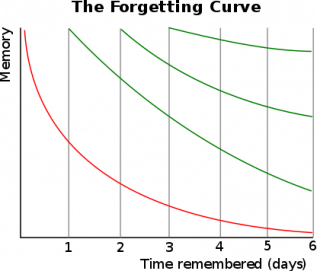
Is Spanish Hard to Learn?: Challenges and Solutions at Every Level
Now that we’ve looked at some of the more theoretical aspects of learning Spanish, let’s move on to specifics.
No matter where you are on your Spanish journey, each level presents its own unique challenges. Whether you’re figuring out where to start or finding ways to sound more natural — there’s plenty to think about.
The good news is that the road to Spanish proficiency is well-worn, and there are reliable methods for getting over even the trickiest hurdles. Let’s take a look at some of the most common challenges learners face at each level alongside some actionable advice.
Beginner
This can be the most harrowing stage of learning for many aspiring Spanish speakers. The uncertainty that comes with starting out can be intense.
Fortunately, this is also the stage where it’s possible to make the quickest progress — you’ve just got to get some momentum! Here are some common roadblocks you may experience when getting started with the language.
Where Should I Start?
Trying to answer this question on your own can be a daunting prospect. There’s just so much to learning a language that deciding where and how to start can be overwhelming.
One of the more important things to consider is your goals. If you’re aiming to nail a handful of phrases to impress your friends or quickly achieve the basics of navigating a Spanish-speaking environment, this practical approach laid out by Benny Lewis includes some great advice, such as:
- Learn the words that you are most likely to use.
This means learning vocabulary that’s relevant to your life. Being able to answer questions like “Where are you from?” and “What’s your profession?” can come in handy quite often. - Look up English/Spanish cognates. These are words that are similar or exactly the same in both languages. Beware that there are around 20,000 of these, so don’t try to memorize them all! Learn cognate patterns to develop an instinct for which words are more likely to have cognates. It’s also important to be wary of false cognates: words that look like they have an English counterpart but have different meanings.
If you’re looking to take your Spanish abilities further than travel basics, you may want to focus on building a foundation that can take you to higher levels and provide deeper understanding. This means learning things like the alphabet, important words, pronunciation, and sentence structure.
One approach is to study a list of the most commonly used words in Spanish when you’re getting started. Consider this vocabulary list from Fluent Forever — the list is in English, so you’ll need to find the translations yourself, but they’re 625 of the most commonly used words in any language, come with illustrations, and are grouped together in stories to aid in memorization.
Alternatively, you could study with Clozemaster to learn the most common words via SRS and context sentences, or study lists of the most common words via Memrise or Anki.
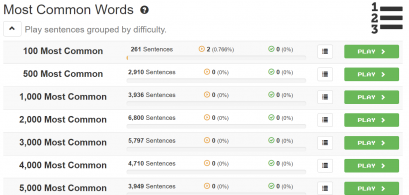
Various groups of common words on Clozemaster.
If you’d like more structure in your studies, consider taking an online course. There are a ton of these, so you won’t be short on choice, and there’s probably something out there you’ll find appealing. We’ve compiled our top picks for Spanish courses in this post, but we’ll also look at a few great options below.
In addition to courses, you might consider one of the many apps available for learning Spanish. Many courses are available as apps, but there are also those with narrower focuses that may appeal to you. Check out our list of top choices for Spanish apps.
How to Speak Spanish? Getting Early Speaking Practice
To speak, or not to speak, that is the question for some beginners. Or maybe more commonly: how much should you be speaking?
There isn’t a universal answer here — you’ll have to take into account your goals, previous language experience, and learning style. Popular polyglot Luca Lampariello goes into detail about this in his video.
As far as actually getting speaking practice, let’s look at some advice as well as some tools you can use:
Talk to yourself
Whether you realize it or not, this is a totally normal and common practice among language learners. It can help you make a physical connection to Spanish, help you grow comfortable producing the sounds, and highlight words or phrases you should learn. Here’s Rob MacPherson’s take on learning to speak without speaking to people.
Practice pronunciation
Pronunciation is an important part of speaking, but learning it can be difficult. This is especially true when you’re just beginning and not accustomed to hearing or producing Spanish sounds. But, a little bit of pronunciation confidence can go a long way in making your speaking practice more effective.
There are many techniques for improving your pronunciation, but this ultimate guide by The Mimic Method is a solid place to start. Practice techniques like shadowing and backchaining are two useful exercises that can take you further — we’ll go into greater detail with these at the end of this article.
Even with guides and methods, it can be difficult to assess your own pronunciation skills. One way around this is to get feedback from a native speaker. In addition to tutors and language exchange partners, you can get this type of feedback from Speechling. Among other features, the site allows users to submit recordings of their pronunciation to be evaluated by teachers. Here’s our full review of Speechling.
Additionally, check out Forvo to hear native speakers from various countries pronounce specific words.
For additional ideas on developing great pronunciation in any language, check out the 10 Golden Rules for Great Pronunciation in Any Language by Luca Lampariello.
Find a tutor
Tutors can be great for getting speaking practice, especially when you’re at a lower level. Online marketplaces like SpanishVIP and italki make it possible to connect with native speakers who will correct your mistakes, listen patiently, and steer you in the right direction. For more tutor platforms, see our list of italki alternatives.
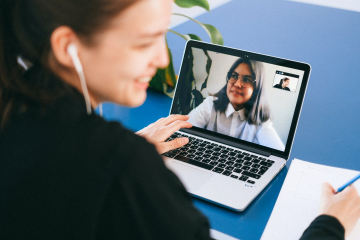
Just like every learner is unique, so is every tutor, and finding one that’s right for you doesn’t always happen on the first try. See this video on how to find the right tutor and this one on spotting a great tutor to learn more.
You can also read our full reviews of SpanishVIP and italki.
Find a language exchange partner
Similar to connecting with a language tutor, finding a language exchange partner grants the opportunity to converse with a native speaker. Some of the differences are that your partner will also be interested in practicing your native language and that it can be free.
This can be a great way to make friends, increase motivation, and learn things about Spanish you might not catch in a textbook or course. While some platforms offer built-in language tools to help facilitate conversations between you and your partner, it can be difficult for beginners to maintain conversations for very long.
Some great, free apps for finding language partners are HelloTalk and Tandem. Or, if you’d like to voice chat with a random Spanish speaker, try Lingbe. Here is our full HelloTalk review, our Tandem review, and this is our mini-review of Lingbe.
For even more options, see our Language Exchange Showdown article.
Overcoming the Fear of Making Mistakes
As we mentioned earlier, this is a major part of any language learner’s journey. And while mistakes are things we instinctively try to avoid, they can be incredibly helpful forces while you learn Spanish.
Mistakes can point out weaknesses in your language ability, giving you insight on what you should be studying, and they’re a signal that you’re pushing yourself into new territory — something that’s necessary for growth!
But knowing that mistakes are an essential and even useful part of language learning doesn’t necessarily make them easier to handle. In this guest post on the I Will Teach You A Language blog by writer Julia, she details some strategies for making the most of your mistakes as well as tips for getting over any fear you may have.
Among other suggestions, Julia recommends resisting the urge to compare yourself to others and talking to yourself to build confidence.
Tricky Grammar
There are some basic grammar points that can be especially difficult to manage at first, but their mastery will lead to a solid foundation in Spanish. Let’s examine a few concepts that don’t quite function like we might expect them to when approaching them from an English perspective.
Por vs para
Depending on which translation tool you use to translate the word “for,” you could come up with either por or para as the first result. So which one is correct? What gets complicated here is that they can both mean “for,” but they can also take the place of other English prepositions as well.
This breakdown on the Lawless Spanish site provides a clear look at the uses for each. For video explanations as well as practice activities, check out this lesson from our Curated Spanish Course.
Verbs like gustar
A rewarding stage of beginning Spanish is learning how to say what you like and don’t like. Me gusta el sushi. No me gustan las arañas. It’s handy to be able to express our likes and dislikes early on, but the grammar moves involved aren’t the most intuitive for English speakers.
In basic terms, we conjugate gustar according to the thing being liked, not the person doing the liking. Gusta is used for singular objects, and gustan is used for plural:
Me gusta el gato. “I like the cat.”
Me gustan los gatos. “I like the cats.”
The person doing the liking is indicated by an indirect object pronoun: me, te, le, nos, os, les.
Me gusta el gato. “I like the cat.”
Te gusta el gato. “You like the cat.”
Gustar isn’t the only verb that works like this, either. There are a whole host of similar verbs, so it’s worth becoming comfortable with this construction. For a clear explanation and plenty of examples with gustar and other verbs, check out this page on the Happy Hour Spanish website.
Ser vs estar
Just like it can be difficult to know when to use por and para, knowing when to use ser or estar can take some getting used to. Both verbs mean “to be,” but each has its own particular uses.
Here’s a broad, simplified explanation: ser is used to describe what something is, i.e., its permanent state; estar is used to describe how something is, i.e., its impermanent state.
For example, I would use ser to say that “I am an American” because nationality isn’t something that usually changes. On the other hand, I would use estar to say “I am happy” because a person’s emotions are something that does change.
Naturally, there are exceptions to this oversimplified explanation. Estar is used to describe location, for example, even when it isn’t something that changes, e.g., “Madrid is in Spain.”
For a more detailed explanation and a handy mnemonic device, see Baselang’s post on the differences between the two.
Grammatical gender
Learning how to correctly use grammatical gender in Spanish is another concept that could be puzzling to native English speakers, but it’s key. Each Spanish noun is either masculine or feminine. This information influences which articles we use as well as how we form adjectives. In other words, it’s important!
While there are patterns you can learn to automatically know the gender of many nouns (for example, those ending in -o are generally masculine, and those ending in -a are generally feminine), there are exceptions to these rules. This makes memorizing the gender of a noun just about as important as memorizing its meaning. Paying attention to grammatical gender early on can make your life much easier further down the road!
Here’s a lesson from our Curated Spanish Course explaining things further.
Intermediate
If you’re at the intermediate level, congratulations! It’s no small feat getting this far, and that can be easy to forget. It’s not uncommon at this level to feel like you’re making slower progress than you were as a beginner. Remaining mindful of how far you’ve come and accepting that progress at this stage may not be instantly recognizable are two great steps you can take for yourself.
In this section we’ll look at some commonly experienced difficulties for learners at an intermediate level: the intermediate plateau, troublesome grammar, advice for improving your pronunciation, and things to focus on.
Intermediate Plateau
This phenomenon is most typically marked by the feeling that you’re not making progress as quickly as you once were — it can feel like you’re stuck at your current level and aren’t able to advance further.
One of the reasons this happens is that the new words you’re learning are used less frequently than the words you already know. It may take longer for new words to transfer to your long-term memory because you won’t come across quite as many instances of the word in the wild.
If you’re feeling a lack of motivation or frustration because you don’t feel like you’re making any progress, know that you’re not alone! It takes a tremendous amount of work to make it past the intermediate stage.
Tricky Grammar
As your command of the Spanish language grows, you may find that there are some grammar concepts that just don’t seem to want to stick. Mastering these concepts is a necessary part of learning to express yourself more accurately and naturally in Spanish.
Subjunctive
You’ve most likely had a few encounters with this grammatical mood by this stage, but that doesn’t mean it’s become second nature. The fact that the subjunctive mood is rarely used in English can make it difficult to fully grasp.
For extra help, learn the WEIRDO acronym and take a practice quiz at SpanishDict.
The WEIRDO acronym details some common situations in which you’ll likely need to use the subjunctive:
Wishes — This includes desires, hopes, and wanting.
Espero que llueva mañana.
I hope it rains tomorrow.
Emotions — Expressing emotions can require the subjunctive.
Me sorprende que pienses así.
I’m surprised you think so.
Impersonal Expressions — These express an opinion, value judgment, or subjective truth.
Es dudoso que venga Adrian.
It’s doubtful that Adrian is coming.
Recommendations — Suggestions and wanting someone else to do something fall into this category.
Recomiendo que hagas más ejercicios.
I recommend that you exercise more.
Doubt/Denial — This includes questioning the reality of something or implying that something is hypothetical.
No creo que me entiendas.
I don’t think you understand me.
Ojalá — This word is used to express very strong wishes or hopes and comes from Arabic.
Ojalá encuentres trabajo pronto.
Hopefully, you find work soon.
While the WEIRDO acronym can be useful for remembering different situations that require the subjunctive, it isn’t comprehensive and won’t be the best method for all learners. Consider this step-by-step guide on Spanish Obsessed if you’re interested in more of a deep dive.
Pronominal verbs
Pronominal verbs are those that are always accompanied by pronouns. It can be difficult to get a grasp on these, in part because they have several different uses, but also because pronoun placement can be a tricky affair.
This introduction to pronominal verbs by Lawless Spanish does a good job of outlining common uses of pronominal verbs. It also includes links to relevant quizzes for registered users.
Preterite vs imperfect
Both of these past tenses are used constantly in Spanish, and becoming comfortable with distinguishing between the two will make your life much easier.
In the simplest terms, the preterite is used to describe a single event that happened at a specific time in the past, and the imperfect is used to describe events that were ongoing or without a specific time period.
For a more detailed explanation of the uses of each, check out this description on SpanishDict. You can also find a variety of practice quizzes to take here (use the left-hand panel to find more).
Continued Pronunciation Practice
By now, chances are you’ve got a pretty good handle on the basic sounds of Spanish. But there’s a difference between being intelligible and easy to listen to. At this level, you might be ready to take your speaking skills to the next level by improving your pronunciation.
This blog post by Trevor Huxham could provide a valuable refresher to English speakers looking to sound more natural. If you’ve got a Spanish tutor, letting them know that you’d specifically like to focus on your pronunciation is another way to get some focused practice.
What to Focus On
Past the beginner stage but not sure exactly what to work on? Let’s look at some ways to get efficient practice at this stage.
Expand your vocabulary
One way to noticeably increase your Spanish abilities is to broaden your vocabulary. Learning synonyms for words you commonly use is one way to do this, and it will allow you to better express yourself. Check out some useful synonyms in this post to spice up your Spanish.
Another way to expand your vocabulary is to learn to speak about different topics than you normally would. You may be very comfortable with introductions and talking about your life or job in Spanish, but what about music, philosophy, politics, or the news? Forcing yourself to practice writing or talking about these topics can be enlightening — you’ll identify a whole world of new vocabulary to learn.
Try native materials
At the intermediate level, you’re ready to start engaging with some native materials, if you haven’t already. Books are great because they’re available at a variety of levels. Try young adult or even children’s books to find something that’s just challenging enough. You can also try movies, TV shows, or videos on YouTube for native Spanish content.
Finding quality material at your level can be difficult, but we’ve done a lot of the work for you! Browse our Spanish Comprehensible Input Library for readings, videos, and listening material at your level.
Learn fillers
Fillers are words that people often use unconsciously in conversation. They don’t always carry much meaning, but they can make a world of difference in making you sound more natural.
This post on Spanish Obsessed provides a great breakdown of a whole host of useful words and phrases. There is some variation between Spanish as it’s spoken in different countries and regions, but this list is useful anywhere. Looking up idiosyncrasies that are particular to a region you’re interested in is a great way to further your Spanish skills.
Advanced
The more you know, the more there is to learn. For many, the experience of being an advanced Spanish learner can be characterized by a continual discovery of new things to learn. Languages are so dynamic and nuanced that truly pinning one down and understanding every aspect of it may never be possible.
In the spirit of taking Spanish abilities as far as they can go, let’s look at some ways in which advanced learners can hone their Spanish abilities even further.
How Can I Sound More Natural?
It is entirely possible to have incredible Spanish abilities and still sound like someone who is clearly speaking a second language. At this stage, narrowing the gap between your skills and native-like proficiency can be extremely difficult.
Of course, you may not feel the need to sound as close to native naturalness as you possibly can, but expressing yourself as fully as possible and bonding with native Spanish speakers on a deeper level is a worthy prize.
One way to sound more natural is to increase the amount of input you’re getting, especially in Spanish as it’s spoken in a specific region. Since each region of Spanish speakers has its own accent, slang, and quirks, choosing to deep dive into one of these will help you sound more like a native speaker.
Understanding and Using Slang and Informal Speech
This can be one of the most difficult aspects of mastering Spanish, but it also creates exciting opportunities for self-expression and deeper cultural understanding.
Unfortunately, the vast majority of resources for learning Spanish don’t pay much attention to this type of language. This is probably in part because slang and informal speech vary from region to region, but also because many learners simply don’t have the need to learn them.
Gritty Spanish is one of the few resources that actually makes this type of language a priority. The practice features high-quality audio recordings of native speakers and authentic speech. These recordings include a wide variety of Spanish accents and their associated slang, making it a great way to get lots of exposure. We wrote this full review of Gritty Spanish if you’d like to learn more.
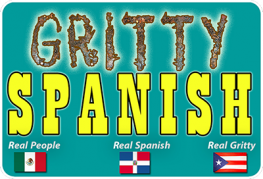
The ideal strategy for quickly acquiring a bunch of colloquial speech could be to have a large group of native-speaker friends who share similar interests and are always available to hang out — unfortunately, there are plenty of reasons why that might not be possible.
If you’ve got a specific, slang-related question you’d like to ask a native speaker, you could very well find your answer on HiNative. It’s a site where language learners can ask native speakers questions about their language. This is a good place to look for information you can’t easily find in a textbook or with a quick internet search.
Another method for learning to understand and produce slang and informal speech is to increase your input to authentic material. Exploring the Spanish-only spaces on social media sites like Facebook, Instagram, or Twitter has the potential to open up a whole new world.
Listening to podcasts in Spanish and watching Spanish-language TV shows or movies are other ways to bring more authentic, informal Spanish into your life.
How to Learn Spanish on Your Own?
There are a million ways to learn a language, and the more you’re aware of, the more likely you’ll find some that work for you. In this section, we’ll go over some popular, effective techniques you can use to learn Spanish by yourself and take it to the next level.



Immerse yourself in a Spanish language course
The best way to learn Spanish is to immerse yourself in the language as much as possible. This means learning vocabulary and grammar rules in the context of daily situations or larger conversations. This helps you learn Spanish quickly and effectively than with other language learning methods.
Immersion doesn’t necessarily mean throwing yourself into a full-speed conversation with the first native speakers you meet, or turning on a telenovela and expecting to magically absorb Spanish. This is what typically comes to mind when people think of language immersion, but for the complete beginner, it’s unproductive and overwhelming.
You want to gradually immerse yourself in Spanish based on your level of the language. A good Spanish course will allow you to do this through speaking practice, or listening and reading. One of the best courses for learning Spanish this way is the Story Learning course, which takes you from a beginner to intermediate Spanish speaker by using real Spanish stories.
Download a language-learning app
One of the biggest factors for success in language learning is consistency. You want to interact with the Spanish language as often as possible to help reinforce what you’re learning. This is what makes language learning apps so powerful. They allow you to learn Spanish wherever and whenever you want!
Pimsleur is a great app for learning Spanish because it uses a special call-and-response technique to teach you conversational Spanish. It’s a great way to practice speaking Spanish anywhere using just your phone.
Subscribe to a Spanish learning podcast
Podcasts are a great way to learn Spanish because they are essentially bite-sized language lessons. Podcasts offer several advantages as a study medium: they’re portable, convenient, often free, and can be great for improving listening skills. They also help take the pressure off of the language learning process with quick, fun, and engaging Spanish practice sessions.
For added value, many podcasts for learning Spanish include transcripts for their episodes. This makes it possible to engage with audio that pushes your listening abilities while having a reference to keep you on track.
We’ve compiled a list of some great podcasts to learn Spanish. Advanced learners can also use Spanish-language podcasts to interact with authentic material in other subjects they’re interested in. Spanishpod101 is one of our favorite podcasts for learning Spanish because it uses actual conversations to help you study Spanish. Also, ivoox is a particularly good app for learners looking to get exposure to interesting content in Spanish.
YouTube Channels
YouTube is another incredible resource for language learners. There are channels teaching just about every aspect and level of Spanish, and each has its own style. You’ll find videos with a traditional classroom feel, some walking you through real-world scenarios, and others in a variety of outdoor settings.
There are so many YouTube channels for learning Spanish that there’s almost certainly several that appeal to you. See this list of the best channels for learning Spanish to get started.
Watch Spanish movies and TV shows
Listening to Spanish music or watching a Spanish movie or TV shows are all fun and effective ways to use your target language. It’s also a great way to dip your toes into Hispanic and Latino culture. Depending on your language level you may want to watch movies with Spanish subtitles or read along with the lyrics of a Spanish song.
FluentU is a great resource for learning Spanish through video. The app lets you easily switch between Spanish and English subtitles. You can even click on a word and instantly see its definition and pronunciation. Lyricstraining is another great tool you can use to practice Spanish using music.
Oral fluency with 4/3/2
This is a method used for developing oral fluency skills. It basically involves speaking on a topic three times, each with a shorter duration than the last.
For example, you could task yourself with speaking about what makes your hometown special. You would first speak for four minutes, take a break, and then start over, only giving yourself three minutes. In the final round, you would only speak for two minutes. In classrooms, this activity is usually done with a partner, but you can simply record yourself speaking instead.
The idea here is that through each shorter time period, you’ll be improving your ability to say things concisely and won’t need to spend as much time searching for the right words or phrases.
This technique has been shown to have positive lasting effects in this study and in this one. To read more about this method, read Gianfranco Conti’s blog post detailing how he uses it in his classroom.
Pronunciation Exercises
Shadowing
Shadowing is a technique in which the learner “shadows” a recording of a native speaker by trying to repeat what the speaker is saying as quickly and accurately as they can. This can be extremely challenging, but it’s a great exercise for getting used to the rhythm of Spanish and the movements your mouth needs to make.
You don’t need to understand the words you’re saying (or trying to say) in this exercise; the focus is on making the correct sounds instead of understanding the meaning. This post on Freeed describes the steps of the process in detail.
To take this further, you can record yourself using Audacity to more closely compare your speech to the target audio. Simply recording yourself speaking Spanish and listening back to your speech is another great way to improve pronunciation.
Minimal Pairs
While it isn’t necessary to memorize the International Phonetic Alphabet (IPA), there are some phonemic qualities that are good to be aware of. Minimal pairs are two sounds that only differ by one phonological element. In other words, they’re two sounds that are very similar and may be hard for learners to distinguish.
In English, /f/ and /v/ are a minimal pair. Try saying the words “fan” and “van” out loud and paying attention to how similar they sound. In Spanish, the /n/ and /ɲ/ sounds are a minimal pair, as in the words, pena and peña. Creating flashcards with audio recordings of each is a good way to practice these sounds.
Backchaining
This pronunciation practice technique takes a back-to-front approach. When learning how to pronounce a new word or phrase with backchaining, you’ll start by producing the last syllable or word first. For example, if you’re learning to pronounce escondido, you would do so in the following steps:
do
dido
condido
escondido
For the phrase Vivo en Puerto Escondido, you might say:
Escondido
Puerto Escondido
en Puerto Escondido
Vivo en Puerto Escondido
One of the advantages of practicing pronunciation with this technique is that the new language you’re practicing in each iteration comes at the beginning. This makes it less likely that you’ll forget the new word or syllable and makes it easier to build into the longer utterance.
Studying With Flashcards

Flashcards are probably one of the oldest ways to practice memorization. The first copyright claim for “flash cards” was filed over a century ago, and they’re still a popular study method today.
But, are all flashcards created equally? Is there more than one way to study with them? While their simplicity may have made flashcards a successful mainstay in memorization practice, there is certainly more than one way to go about using them.
We spoke about spaced repetition systems at the beginning of this post, and flashcards are a wonderful fit for this technique. It’s possible to build an SRS with paper flashcards using the Leitner System, and this is a reasonable option for tactile learners or those with an aversion to flashcard apps.
The Leitner system does require a bit of preparation, unfortunately, and there are digital solutions that are more convenient. The most popular flashcard app is probably Anki, which boasts fully customizable flashcard creation and the ability to tweak the SRS to your preferences.
Regardless of how you use your flashcards, how you create them is also important. More than simply including a Spanish word on one side and its English translation on the other, you can take your flashcards to the next level by including images, audio, example sentences, and more.
One concept to be aware of when making flashcards is that emotion plays a large role in memory. You can take advantage of this by using images or example sentences in your flashcards that you can relate to on some kind of personal level.
Keeping a Diary

Creating diary entries in your target language can be both rewarding and an effective way to guide your studies. Writing in your target language can help you develop a deeper understanding of sentence structure as well as useful vocabulary, especially at lower levels.
While getting feedback on your journal entries isn’t necessary for self-study, it can be enlightening and provide reassurance. Journaly is a site that was designed specifically for this and is a great option for those that don’t mind making digital journal entries.
Back Translation
Sometimes referred to as reverse translation, this technique might not appeal to everyone, but it does offer some advantages to the willing learner. Back translating is the act of translating a piece of a previously translated text back into its original language. The final stage is comparing this translation with the original text.
It’s a practice that’s sometimes used by professional translators to verify the accuracy of a translation, but it also offers insights into any knowledge gaps you may have.
Olly Richards has detailed some step-by-step instructions for those interested in using this technique to study grammar on his website.
Standardized Tests

This is another self-study technique that can be valuable for pointing out areas for improvement and for gauging progress. It’s important to remain mindful, however, of the differences between standardized tests and real-world fluency.
The skills required for taking standardized tests require a high level of accuracy and usually happen in a quiet environment when you’re focused. Real life doesn’t usually require great accuracy and is quite unpredictable.
This means that it’s entirely possible to become more skilled at one than the other. Keep in mind that standardized test performance, while informative, doesn’t necessarily represent your overall Spanish skills.
DELE

The Diplomas de Español como Lengua Extranjera (DELE) are standardized Spanish exams produced by Instituto Cervantes, a Spanish organization responsible for promoting the teaching and study of the Spanish language.
The DELE exam is the most widely recognized standardized exam and is often required by universities or employers that want to verify a candidate’s Spanish proficiency. There is a different exam for each CEFR level, from A1–C2, meaning you’ll need to decide which to test for ahead of time.
To officially take the exam, and receive a score and a diploma, you’ll need to register and pay a fee. The price varies based on the location of the testing facility and the level of the exam. There are certified testing facilities in over 100 countries, and exams take place five times each year.
Fortunately, Instituto Cervantes also makes the exams from previous years available for free on their website. These can be useful for self-evaluation and practice — there are answer keys for the multiple-choice questions, but you won’t get official feedback on your writing or speaking skills.
See this website for additional information and links to many more Spanish proficiency tests.
Hone your Spanish skills with online lessons
One-on-one lessons with a Spanish teacher will help you with more difficult grammar rules and vocabulary. A good teacher will help you identify your weak points and provide you with practice and assignments to address them.
If you ever feel stuck while learning Spanish, then consider booking an online lesson with a Spanish tutor or teacher. Baselang is a great site that connects language learners with teachers from across the Spanish-speaking world.
Practice with native Spanish speakers
Once you have some basic Spanish phrases under your belt, I highly recommend you try using them in the real world. Talking with native speakers for the first time is often one of the most nerve-racking steps when learning Spanish, but it’s also one of the most rewarding.
Nothing cements a new Spanish word in your brain like using it in a conversation. Practicing with native speakers also adds a relational (ie human) element to the learning process. At the end of the day, Spanish is a language, and languages are used to connect people.
Sooner or later you have to take the leap and start practicing Spanish with a native speaker. This could take the form of a language exchange partner or maybe a Spanish conversation club. Check meetup.com for local Spanish clubs. My Language Exchange is a great free online language exchange. There you’ll find a lot of Spanish speakers looking for native English speakers to practice with!
No matter how many words you do or don’t know, get out there and start making some human connections in your new language. You won’t regret it!
Visit one of the many Spanish-speaking countries
For many Spanish students, visiting a Spanish-speaking country is one of the main reasons why they want to learn a foreign language. Visiting a country like Spain or one in Latin America can help solidify your Spanish-speaking skills in a way that no course or program can.
We recommend traveling abroad to a Spanish-speaking country only after you have a solid foundation in the language. This will make your trip more fun and effective!
What no one told me about learning Spanish
It wasn’t that long ago I was sitting where you are now, glued to Google searching for how to learn Spanish online. And like you, I was overwhelmed with ads and reviews all claiming to know how to learn a foreign language.
Taking the bait, I downloaded language apps, listened to Spanish podcasts, and forked over my hard-earned money for an expensive language course or two. I even started taking virtual lessons with a few Spanish teachers online.
The end result? Besides burnout and the fact that I used less than half of all the resources I bought or downloaded; after several months I discovered that despite my best efforts I still couldn’t speak Spanish.
I felt frustrated and discouraged. I spent money, and I practiced Spanish as much as I could. But at the end of the day, I struggled to understand even short Spanish expressions. I definitely couldn’t come up with any Spanish sentences on my own.
My language learning journey hit a brick wall and I started to wonder if it was even possible for me to learn a foreign language at all.
Then I realized that all the methods I was using to learn Spanish were essentially the same. They all used a translation-first approach. These courses taught Spanish vocabulary by simply giving me a list of words or phrases in Spanish, and then giving me the English translations.
There was no context for the vocabulary I was learning. If grammar rules were taught they were taught solely through example sentences. Most of these sentences were so basic and odd that they were pretty much useless when it came time to talk in real-life situations.
I went back to the internet and searched a little deeper than the flashy ads and dime-a-dozen review sites. It took some digging but I discovered that other Spanish learners shared my experience. Even better, I found some Spanish language resources that deviated from the traditional translation-first approach.
These language courses emphasized Spanish immersion. They taught Spanish in an effective and practical way. The end goal of these courses was to get me ready to interact with Spanish-speaking people in the real world. Here’s a quick list of the effective resources I found and used to learn how to speak Spanish.
Learning Spanish: Answering Your Spanish Language Questions
How to Learn Spanish Fast?
Based on my experience, consistent study using an immersion-based method is the fastest way to learn Spanish. Your Spanish skills will develop faster the quicker you can speak in your new language without having to translate from your native language. Whatever your motivation may be, if you want to learn Spanish quick, check out my post about the fastest way to learn Spanish.
How much Spanish can you learn in a month?
This largely depends on how much time per day and week you are able to spend learning Spanish. Assuming that Spanish is your first foreign language, and you’re able to consistently spend at least an hour a day learning the language, you could expect to have simple conversations by the end of the month.
Don’t try cramming in your Spanish learning by spending 8+ hours a day studying and expect to be fluent in a month. That’s nothing but a recipe for burnout and discouragement. It’s much more beneficial to think of learning Spanish as a lifelong hobby or adventure, and not simply a task to master as quickly as possible.
Can I become fluent in Spanish in a year?
The Foreign Service Institute estimates that a native English Speaker will need 23-24 weeks to learn Spanish proficiently. This assumes 575-600 hours of study during the 23-24 week period, which comes out to around 25 hours of study and practice each week.
Long story short, yes it’s completely possible to become fluent in Spanish in a year. It could take as little as six months depending on how much time you dedicate to learning Spanish. Check out our detailed post answering how long does it take to learn Spanish.
How can I learn Spanish by myself?
There are tons of language learning tools available for those who want to learn Spanish by themselves. Many of them have already been discussed in this article. If you’re a self-learner just make sure you’re using an immersion-based approach and getting a healthy dose of grammar and vocabulary.
Keep in mind though that if your end goal is to speak Spanish you will have to eventually practice speaking with other people.
What’s the easiest way to learn Spanish?
The easiest way to learn Spanish may vary from person to person. Different individuals have unique learning preferences and styles. The key is to find the right combination that works best for you and fits into your daily routine. We’ve listed some tips for you to discover the easiest way to learn Spanish that’s fit for you.
Am I too old to learn Spanish?
If you’re alive and breathing then you aren’t too old to learn Spanish. It’s true that small children have some language learning advantages that adults don’t. Small kids don’t have much to worry about in their day-to-day lives so their minds are a lot freer to learn a language.
Kids also aren’t afraid to learn from mistakes and the people around them are constantly speaking with them at their level of understanding and giving positive feedback.
But adults also have some advantages that the younger Spanish learner doesn’t. Adults learning Spanish as a second language have at least one language (their native language) already under their belt. Adults also have more information about the world around them and will have an easier time understanding situational conversations.
So don’t worry if you feel like you’re past your prime when it comes to language learning. The most important parts of learning Spanish are consistency and enjoying the language for its own sake. Cover those two bases and you’ll be speaking Spanish before you know it!
Is Babbel or Duolingo better for learning Spanish?
When it comes to the Babbel versus Duolingo debate I tend to opt for Duolingo because it’s free (mostly). Both apps follow a similar method. They teach you basic grammar rules and vocabulary through translation exercises and then quiz you on what you know.
Neither is my first pick for Spanish learning due to the fact that both Babbel and Duolingo follow a translation-first approach. It’s also important to note that these two apps do little to prepare you for Spanish speaking.
Is Babbel or Rosetta Stone better for learning Spanish?
Babbel would be my pick here, mainly because it’s cheaper than Rosetta Stone. As I just mentioned Babbel’s language learning method that depends heavily on translation exercises and quizzes.
Rosetta Stone on the other hand follows a completely different approach. With Rosetta Stone, you learn a new language entirely through pictures and audio. There are no grammar lessons or explanations in Rosetta Stone. The idea here is by learning through pictures you pick up the language in the same way that native speakers learned Spanish when they were children.
By using only pictures you cut out the translation step and immerse yourself in the language. While this method sounds good on the surface it stops being practical the moment you start learning intermediate Spanish. You’re not likely to pick up difficult concepts like verb tenses or the difference between ser and estar by using only pictures. Sooner or later you will need an explanation for how Spanish grammar differs from English.
Is Duolingo good for Spanish?
Duolingo Spanish is good if you want a quick or novel way to learn or practice basic words and grammar. Even if you work through their entire Spanish course, you won’t be fluent if your only Spanish learning tool is Duolingo. There’s very little pressure in Duolingo to produce your own phrases in Spanish. This means that if you want to speak Spanish you’ll still have a long way to go after working with this app.
Duolingo also isn’t the most effective for listening comprehension. While there are some listening exercises in each lesson, they are short and pretty easy to guess. These exercises are too little to prepare you to understand fast Spanish speech.
All that being said, Duolingo is still a nice way to learn the basics, and it will also help you learn to read and write in Spanish.
How to Learn Spanish for Free?
If you’re on a budget or just testing if Spanish is for you, learning Spanish for free is entirely possible. Thanks to the plethora of online resources and diverse learning approaches available to learn Spanish free. Lucky you, we’ve tested hundreds of Spanish resources and a good chunk of those are free. To help you choose what could work best for you, here’s a guide I made specifically for learning Spanish online for free.
In Closing
If there were a singular, get-fluent-fast trick that worked for everyone, this post wouldn’t be so long. Learning Spanish requires time and dedication, and many methods work better for some than others.
The good news is that resources for learning languages are more accessible today than they’ve ever been before. If you’ve got your mind set on achieving Spanish goals, there’s nothing that can stop you.
Related Posts for Learning Spanish
- Best books to learn Spanish
- Easiest Way To Learn Spanish – 10 Tips To Try Today!
- Learn Spanish Fast – The Ultimate Guide
- How Long Does it Take to Learn Spanish
- All the Free Resources You Need to Learn Spanish
- Ser Conjugation: All Language Resources Quick Guide
- Ver Conjugation: All Language Resources Quick Guide

